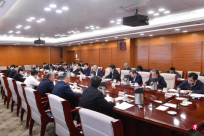
At the time of China's additional special government bonds, it is reported that the State Council has limited 12 debt high -risk areas to issue new debt and new projects in Malaysia.The analysis believes that under the long -term imbalance of the central government and local debt, recent measures show that the official is using the increase in the pressure of central debt to reduce the pressure of local debt.
Reuters on Wednesday (October 25) quoted people familiar with the matter that a document that the State Council was released in late September had been issued to local governments and state -owned banks this month.The document mentioned that 12 provinces and municipalities autonomous regions including Liaoning, Jilin, Yunnan, Guizhou, Tianjin and Chongqing will only bear specific projects approved by the central government. The construction of railway stations and power plants will not be allowed.
Documents stipulate that the debt growth rate of local government financing platform (LGFV) must not exceed the average growth rate of loans in the province's enterprise.Local governments can only be used in major projects and minority projects approved by the State Council, such as the reconstruction of old communities in urban and towns and the construction of affordable housing.
Different from most major economies, the Chinese government debt is mainly based on local debt.Last year, the total scale of local bonds exceeded 9.2 trillion yuan (RMB, the same below, S $ 17.2 trillion), accounting for 76%of the GDP (GDP).In the past three years, multiple factors such as increasing epidemic prevention expenditure, decreased investment returns, and decreased land income have increased China's local fiscal burden, and also exacerbated the market's concerns about the upgrading of local debt to systematic financial risks.
The Politburo of the Communist Party of China proposed at the meeting held at the end of July that it is necessary to effectively prevent and resolve the risk of local debt and formulate a package of debt planning.The Chinese government issued 1 trillion yuan of government bonds on Tuesday (October 24) to arrange for local governments by transferring payment.Although the official use of these Treasury bonds is to support post -disaster recovery and reconstruction, the analysis believes that some funds will be used to resolve the risk of property markets and local debt.
Since this month, at least 25 provinces and cities in China have disclosed special recycling bond issuance plans for issuance, and the scale of debt issuance has exceeded 1 trillion yuan, exceeding the previous two rounds.Different from ordinary recycling bonds that repay the principal of government bonds due, special reinstate bonds raised funds for replacement of local hidden debt, most of which are bonds by local government financing platforms such as urban investment companies.
A economist who is unwilling to be named was analyzed during an interview with Lianhe Zaobao. Although the news that restricted some local governments issued debt was not officially confirmed, this move was in line with the logic of localized debt.These provinces do not have too many valuable assets that can also be mortgaged. Forcibly issuance of debt will only exacerbate the dilemma of Yin Yin.Whether it is forced state -owned banks to subscribe or attract local financial institutions through high discounts, it may cause financial risks."Turning their local debt into central debt, through economic recovery and development to eliminate the risk of debt, which is currently a more reasonable solution."
This scholar also emphasizes that this approach should only be used as right measures under special circumstances.In the long run, local governments are relatively familiar with local conditions, and they are more suitable for undergoing investment functions and responsibilities for debt issuance. The central government only plays an auxiliary role."Local governments should take this opportunity to improve the investment mechanism to avoid allowing the central government to continue to bear debt."
On the morning of the morning of China's additional national bonds, Zheng Zujie, director of the National Development and Reform Commission, hosted a symposium on some local economic situation to hear the economic situation of various places, difficult issues facing, and suggestions for national economic work next year.
According to the statement issued by the National Development and Reform Commission's official website on Wednesday, the symposiums include the main responsible persons of Beijing, Tianjin, Hebei, Shanxi, Inner Mongolia, Jiangsu, Guizhou, Shaanxi and other places.At the meeting, Zheng Zujie pointed out that it is necessary to soberly treat the difficulties in economic operations, and make a good job of focusing on the key tasks of this year and next to achieve "expanding domestic demand, strong entities, preventing risks, and protecting people's livelihood."
The statement also disclosed that the heads of the National Development and Reform Commission have recently led the team to conduct a survey of the front line of the grassroots, understand the economic operation of various places, and listen to the suggestions of economic work next year.




